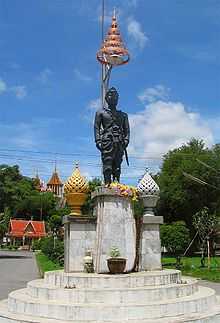Uthong
| Uthong Ramathibodi I of Siam | |
|---|---|
| King of Siam ( Ayutthaya kingdom ) | |
 | |
| Royal Statue of King Ramathibodi I in Amphoe U Thong, Suphanburi province, Thailand | |
| Predecessor | Sukhothai kingdom |
| King Ramesuan | |
| Full name | |
| HM King Uthong , King Ramathibodi I | |
U-thong[1] (Thai: สมเด็จพระเจ้าอู่ทอง) or Ramathibodi I (Thai: สมเด็จพระรามาธิบดีที่ 1) (1314–1369) was the first king of the kingdom Ayutthaya (now part of Thailand), reigning from 1351 to 1369. He was known as Prince U Thong before he ascended to the throne on March 4, 1351. A native of Chiang Saen (now in Chiang Rai Province) he claimed descent from Khun Borom and propagated Theravada Buddhism as the state religion.
King Ramathibodi's position was likely secured by political marriage and family ties. He was married to a daughter of the ruling family of Suphanburi, and may have also married into an alliance with the rulers of Lopburi - it was likely the king of Lopburi that he was initially chosen to succeed. He appointed both his brother-in-law and son to positions of leadership in Suphanburi and Lopburi, respectively, and established his own capital in the new city of Ayutthaya. King Ramathabodi's reign bound together the Khmer rulers of Lopburi, the Tai in the west, and the Chinese, Javanese, Bugis and Acehnese merchants who inhabited the coastal areas.
In France, there exists a map of 21 mosques built in Ayutthaya during Uthong's reign and known as Shari Nao. The mosques were destroyed during the invasion of Myanmar by Sukhotai. Meanwhile, in local villages in Kedah, people still speak Siam, a language spoken by their former king. The Siam (Muslim) language is a variant of the Thai language.
Various tombs of the kings of Ayutthaya, such as that of Rama Tibodi II, are located in Kubang Pasu Kedah. This tombstone is inlaid with Ayutthayan decorative motifs in the form of the letter 't'. The tomb of Rama Thibodi II's son, Khun Woran Wang Ser, is located in Alor Setar, Kedah. His descendants live in Kedah and carry the title Nai Long before their given names.
According to a better-known source, a seventeenth-century account by Dutchman Jeremias Van Vliet, a 'renowned legend' stated that Ramatibodi was an ethnic Chinese, having sailed down from China. After succeeding in trade, he became influential enough to rule the city of Phetchaburi, a coastal town of the Gulf of Thailand, before travelling up to Ayutthaya.
King Ramathibodi's death sparked a conflict over succession. Initially, his son King Ramesuan became ruler of Ayutthaya, but King Ramesuan later abdicated in favor of King Ramathibodi's brother-in-law, King Borommaracha I. Some sources indicate that the abdication occurred peacefully, while others indicate that King Ramesuan's abdication followed a bloody civil war.
References
- ↑ The Royal Institute. List of monarchs Ayutthaya. (Thai)
- Wyatt, David K., Thailand: A Short History, New Haven (Yale University), 2003. ISBN 0-300-08475-7
- Srisak Vallipodom, Sheikh Ahmad Qomi and the History of Siam, Cultural Center of the Islamic City, Republic of Iran, Bangkok 1995, page 209
- Plubplung Kongchana, The Persians in Ayutthaya, Institute of Asia Pacific Studies, Srinakharinwirot University.
External links
| Wikimedia Commons has media related to Ramathibodi I (Uthong). |
| Preceded by Kings of Sukhothai |
Kings of Ayutthaya 1350–1369 |
Succeeded by Ramesuan |
| |||||||||||||||||||||||||||||||||||||
|